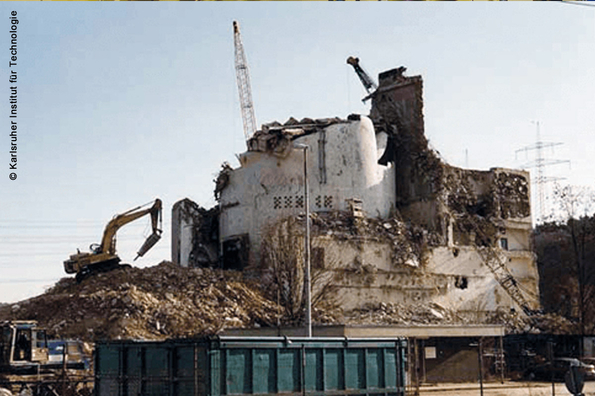Stepwise dismantling of nuclear facilities
The example of a nuclear power plant is used to show how nuclear facilities are dismantled immediately.
Preparation
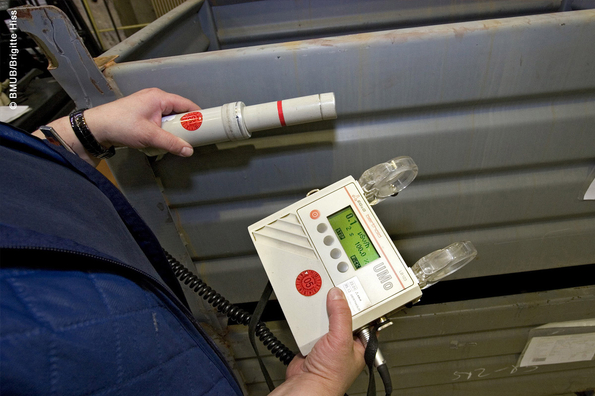
Before dismantling begins, the plant is still in almost the same technical state as after cessation of operation. Fuel and operational waste have, as far as possible, been removed.
In preparation for decommissioning, a detailed overview of the plant’s radioactive inventory is drawn up. For this purpose, the existing data is, where necessary, supplemented with measurements or samples that are then evaluated.
On this basis, the final plan for the dismantling can be prepared. The radiological characterisation is continuously added to and updated in order to support dismantling.
Dismantling in stages
The following figures illustrate dismantling using a simplified cross section of a nuclear power plant. In each dismantling step, the systems, structures and components highlighted in red are removed.
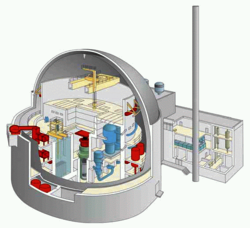
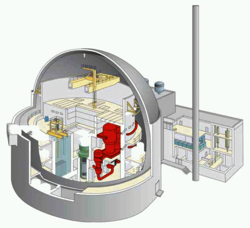
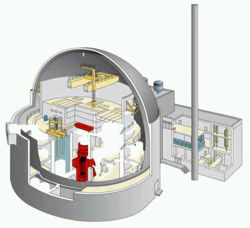
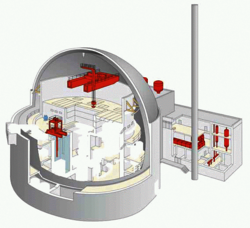
Dismantling in stages
One possible strategy is to start dismantling components in areas with low contamination and then to continue in areas with higher contamination; dismantling is carried out "from the outside in". Equipment needed to segregate, decontaminate and reprocess the waste and residues can then be installed in the vacated areas, for example parts of the turbine building.
Disassembly of contaminated systems and components
Almost all removed parts are disassembled into easily manageable pieces and decontaminated if necessary. Decontamination can take place, depending on the circumstances, before or after disassembly. Each piece is examined for radioactivity. Based on this assessment, a decision is taken on whether the piece has to be conditioned and handed over as radioactive waste, or whether it can be further treated and cleared, which means that it can be fed back into general substance cycles as non-radioactive material.
Computerised systems ensure continuous tracking of the pieces from the place of their dismantling and subsequent treatment steps until their removal from the plant. The logistics needed for residue and waste management are substantial and represent a significant cost factor.
Key installations, such as ventilation, power and media supply, are kept in operation or on standby through all steps of dismantling. These systems are available from the operating phase and their continued operation is essential. Depending on the requirements, they may be retrofitted or replaced with new systems to meet new specifications.
Disassembly of activated components
The activated components include the reactor pressure vessel (RPV), the near-core area made of heavy concrete (biological shield) and the adjacent systems and components within the containment vessel.
For these components, dismantling steps are largely carried out by remote control in order to avoid any human presence in areas of high radiation. Much of the work is carried out under water, since water is an effective radiation shield. In some cases, major components are removed from the plant for decay storage and subsequent segmentation.
The materials arising from this dismantling step are, for the most part, activated. They make up a significant proportion of the radioactive waste produced during decommissioning.
After complete vacation of the building, only residual contamination remains on the surfaces of the building structures. In the final step, they are decontaminated and re-examined for residual contamination. This step is repeated until the contamination is lower than the limit values specified in the Radiation Protection Ordinance.
